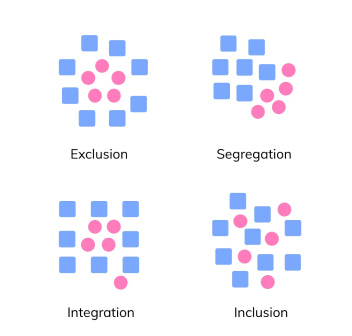What is social inclusion?
An introduction
Design plays a vital role in reaching and impacting various groups. A well-thought-out design can attract the intended audience, but it might also unintentionally exclude others. Especially with widespread products or services, designers should aim to make their work accessible and user-friendly for as broad an audience possible.
“The power of the Web is in its universality.
Access by everyone regardless of disability is an essential aspect”
Tim Berners-Lee, W3C Director and inventor of the World Wide Web
In today’s rapidly digitising world, digital inclusion is key. This concept is about ensuring everyone can access and benefit from digital content. For example, if a product features dense text, it might be inaccessible to those with reading disabilities. Inclusion means that this text is presented in a way that everyone, including those with disabilities, can understand it easily, ensuring no one is left out.


Did you know?
- In 2022, 27% of the EU population over the age of 16 had some form of disablity. According to Eurostat estimates, that equals to 101 million people or one out of four adults in the EU.
- 28.4% of people with disabilities are at risk of poverty or social exclusion compared to 17.8% of people without disabilities.
- In 2022, 95.3 million people in the EU were at risk of poverty or social exclusion. This was equivalent to 21.6% of the EU population.
What makes a digital building logbook inclusive?
Considering the possibility of the digital building logbook (DBL) becoming a mandatory document in the EU member states, it is crucial that these digital platforms address the potentially excluded members of their target market. To explore the common practices in the DBL market, we spoke to the DBL providers in the Demo-BLog consortium on their views, goals and strategies in social inclusivity.
Inclusive Design Strategies
A key conclusion that can be drawn at this point of the DBL implementation and development is that social inclusion is an overlooked aspect in both the design processes and the tools.
At most, these tools comply with the e-accessibility legislation for public access websites at the European level or follow certified guidelines such as the WCAG or W3C Web Accessibility Initiative when developing digital tools, websites and digital content.
Although none of the tools adopted a specific strategy on inclusive design, our discussions shed light to the importance thereof. Several ideas for future directions were proposed. For instance, Cirdax aims to expand on the possibilities of various AI-tools to be integrated to the DBL to support users with disabilities when using the service.
Prototyping & testing
Chimni on the other hand scheduled a re-design of the tool in the coming years to include updates from a UI/UX perspective. They plan on spending some time to identify and understand the different user needs from a wider group of users.
The re-design would be done through an iterative way where a prototype will be created to be tested by diverse user groups, allowing the alignment of the tool with the actual user needs. One key aspect they aim to emphasise on is the use of plain language. It has been identified that language can make certain content difficult to understand, for instance, when describing how renewable technologies work.
Non-digital alternatives
In the case of Woningpas & Chimni, the ambition to creating a non-digital twin for their product.
At Woningpas a printable version of the digital platform is being designed. This new functionality is motivated by the fact that the transactions during the purchasing and selling of a house are still often done with physical documentation.
Providing homeowners with the ability to print their Woningpas increases their accessibility of data at moments of need, ensuring inclusivity in a wider dimension.
Chimni also considers the non-digital twin of the digital tool for homeowners without internet access. This version would offer the option for users to call a telephone number, or speak to a face-to-face advisor who would, on behalf of the user, input the users details into the tool. However, the feasibility of this option still needs to be assessed.